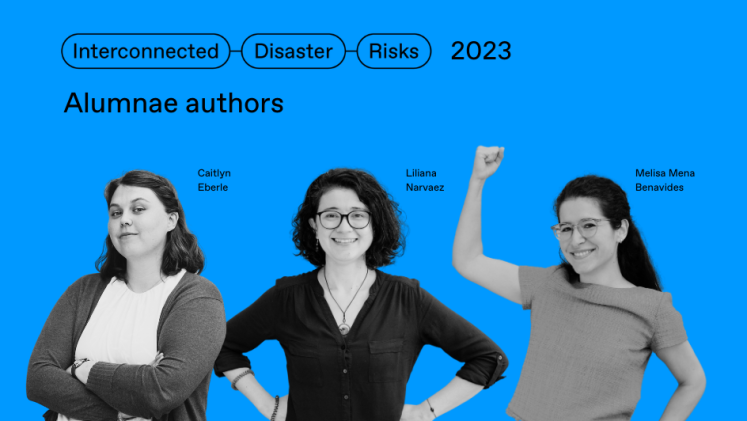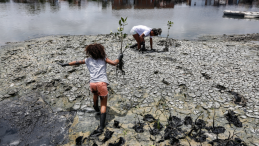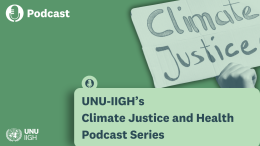The Interconnected Disaster Risks 2023 report was launched last week, receiving significant media coverage. Behind the report is a team of five authors, three of whom are alumnae from the Joint Master’s of Geography of Environmental Risks and Human Security.
Former students Caitlyn Eberle (2018-2020), Liliana Narvaez (2015-2017), and Melisa Mena Benavides (2019-2021) have contributed as Lead authors this year. Eberle and Narvaez have been on the team since the first edition in 2021, while this marked Mena Benavides’ first year.
The new edition shifted focus away from analysing ten disasters to developing the new concept of “risk tipping points”. The report covers six tipping points in our socioecological systems, that if not addressed will lead to potentially catastrophic impacts for people and our planet.
“This year the report is future focused”, said Eberle. “Through our previous work on disasters, we were able to see that we are actually headed toward something much riskier, so we dove into risk tipping points”.
The researchers defined a risk tipping point as the moment at which a given socioecological system is no longer able to buffer risks and provide its expected functions, after which the risk of catastrophic impacts to these systems increases substantially.
The case studies analysed in the report are: Accelerating extinctions, Groundwater depletion, Mountain glaciers melting, Space debris, Unbearable heat and an Uninsurable future.
“We chose these case studies, because we wanted to cover a diversity of subjects and highlight their interconnectivity”, said Eberle. “We also chose tipping points for cases studies where people are already feeling the impacts, as well as those that we might not expect, like Space debris”.
The report finds the cases all share similar root causes and drivers which are embedded in our own actions and behaviours, putting pressure on these systems until they reach the brink of collapse. Once reached, the impacts can be catastrophic for people and our environment. One key takeaway is that we are losing the very tools that can help us manage risks.
The process
Working on the report is an arduous task and getting it to the finish line is a massive effort. The process starts 8 to 12 months before it is launched, and while the researchers do work on other projects, they give a significant portion of their time to the report.
Each researcher is tasked with carrying out literature reviews, researching and writing on specific case studies in the report, which mostly fall under their area of interest. For instance, Liliana Narvaez led the research for the accelerating extinctions tipping point. “In my area of research, I look specifically at ecosystems related losses so I feel close to this tipping point”, Narvaez said. “I liked drawing the interconnections between species and places far away from each other in the world. Our work on the case studies is something we take ownership and pride in”.
For its newest member, Melisa Mena Benavides, working on the report required adapting to new ways of doing research.
“We carry the research out with a different aim. It is about telling a story and bringing our findings to a different audience than most of our papers”, said Mena Benavides. “We as researchers have to adapt how we write and communicate”.
The report is a joint research and communication product for the purpose of making science accessible to all. The researchers noted the biggest takeaway for this year’s report is that collective action is necessary to address risk tipping points, highlighting the urgent need to reach diverse audiences.
“What we try do in the report is make it understandable and accessible for people, which is critical”, said Mena Benavides. “Our goal is to get the message out there, as far as possible”.
Contributions from alumni are not limited to the main report. In support of the main report, technical reports are provided each year. They go further into detail on the science and technical sides of the research. Additional researchers are also pulled into contribute on these individual reports.
Several alumnae from the Master’s programme contributed this year through reviewing and technical report writing, including: Lisa Hartmann, Sally Janzen, Magdalena Mirwald and Jessica Pinheiro.
Joining the three authors on the main report team are Lead authors, Jack O'Connor and Zita Sebesvari, UNU-EHS' Deputy Director and Head of the Joint Academic Board.
To learn more about the Interconnected Disaster Risks 2023 report click here.
Applications to the masters programme are currently open until 15 December. To apply click here.




